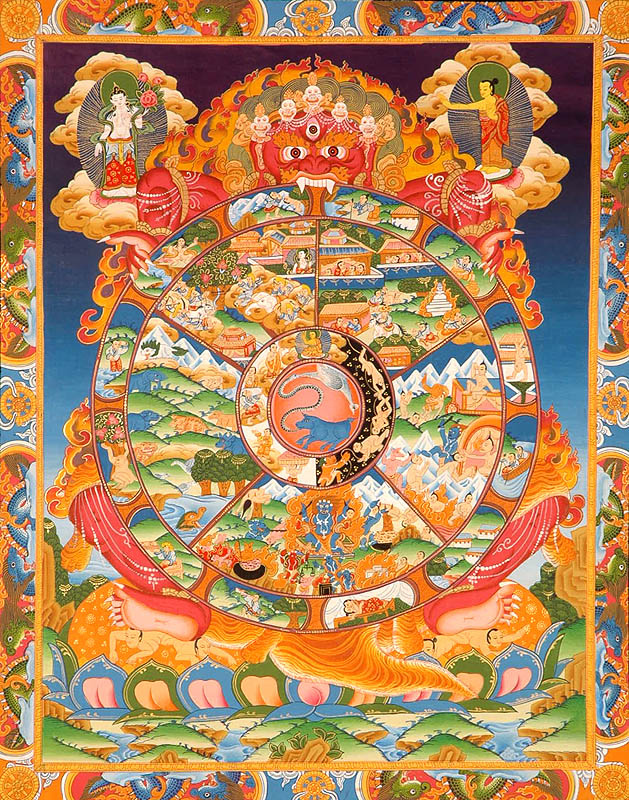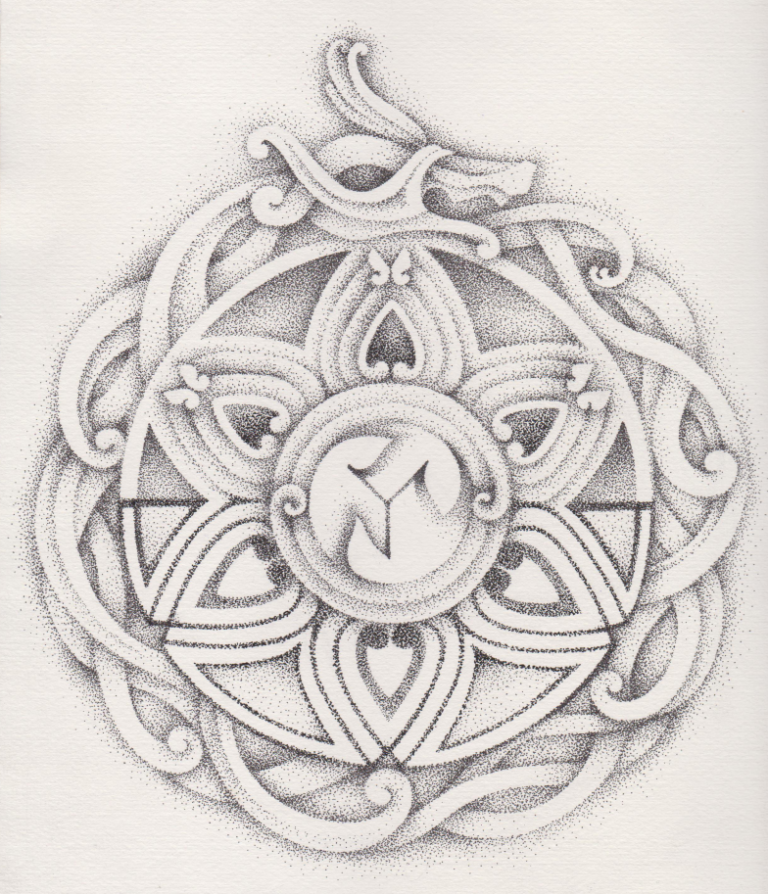Four years ago, I realized I wanted to get a Buddhist tattoo over my heart. I’m not Buddhist by birth or cultural heritage. I’m a white guy who grew up in an atheist home in eastern Washington with no exposure to the tradition until my teenage years.
And I’m not the world’s most devout practitioner. I don’t have a steady sangha. I don’t often make it to temples or prayer centers. And I find myself missing more days of my idiosyncratic meditation practice, cobbled together from piecemeal instruction, than I’d like to admit.
But I found the dharma during a particularly difficult chapter of my life—at first through tattered secondhand books and then through a jumbled exposure to practitioners of numerous lineages. Over the years I made an effort to carve out an understanding of Buddhist thought and practice from my own cultural vantage.
Eventually I started holding myself to the five precepts, practicing mindfulness in as many of my actions as I could, and following the eightfold path, even if I didn’t subscribe to any singular tradition. I was a Western Buddhist, finding ways to understand and realize the dharma through my own culture, which often meant offloading ornate symbologies and esoterica grounded in other traditions in favor of a back-to-basics set of beliefs and practices to guide me through life.
And navigating through a mostly Judeo-Christian world, I wanted a symbol—something permanent—that would remind me of and focus me on my path and practice.

By 2014 I was certain that I wanted this tattoo; I sat on the idea for two years to make sure it was more than an impulsive desire. But when I looked at common Buddhist designs on offer, I froze. It’d become painfully obvious in recent years that many people from the cultures behind these images see their use by outsiders as harmful appropriation. And I wasn’t sure if these designs, used by other societies to communicate Buddhist ideas in their own vernacular, would be as full of meaning for me as they ought to be.
Even after delving into the controversy over the Western use of Asian-origin Buddhist designs for tattoos for some time now, I’m not sure there’re any good guidelines on the subject. In my own case, though, I decided that the best course of action would be to design a new symbol communicating Buddhist ideas through my own cultural background.
Even cultures without their own tattoo traditions, such as Tibet’s, can find this flippant use of traditional symbols disconcertingConcerns about the Western misuse of Asian Buddhist symbols in tattoos have been on the rise in recent years. In 2011, the Thai Culture Ministry proposed a ban on tourists getting religious tattoos. In 2013 and 2014, respectively, Sri Lanka deported British tourists Anthony Ratcliffe and Naomi Coleman, both of whom had Buddhist tattoos on their arms. In August 2015, 15 state officials arrested Jason Polley, a Canadian tourist, and his girlfriend, Margaret Lam, at their Myanmar hostel after photos of Polley’s Buddhist tattoos went viral. And last spring, a billboard appeared next to an international airport in Thailand to inform foreigners that it was inappropriate to get tattoos of the Buddha.
These stories reflect a belief that the foreigners were committing blasphemy. But these casual obscenities were the direct result of a blithe adaptation of symbols without regard for the cultural context in which they are used—and the growing sensitivity surrounding them in some nations may in part reflect a reaction to this seemingly uncaring, growing appropriation.
Spurred by trendsetters like Angelina Jolie, Buddhist tattoos have become a fashion statement in the West over the last decade or so. Often indelibly inked onto consumers because they’re pretty, or based on a shallow understanding of Eastern faiths in general, a fair number of tattoo recipients in the West have used others’ cultures for their own amusement or fulfillment, causing emotional discomfort to many in the cultures from which they’ve appropriated. Even cultures without their own tattoo traditions, such as Tibet’s, can find this flippant use of traditional symbols disconcerting, according to Ben Joffe, a South African anthropologist studying Tibetan diaspora culture.
Yet Western practitioners have a nasty habit of brushing off concerns about these trends. Coleman, Polley, and Ratcliffe all expressed mild indignation that they should be criticized for their body art, as they each claimed to be one sort of believer or another. They seemed to believe this absolved them from charges of blasphemy, appropriation, or both.
Some Western Buddhists also argue that concerns of cultural appropriation are immaterial in Buddhist matters because Buddhism is a universal belief system, open in concept and imagery to all. Particularly zealous converts, says Joffe, especially those exposed to the dharma by teachers from Asian lineages and using Asian symbols, dismiss such critiques as worldly and unevolved.
Beyond the context of cultures with tattooing norms, it’s the indignity of having one’s culture exoticized.There are Buddhists in the cultures that produced these designs who might agree with the notion that these images are ultimately empty and that it doesn’t matter if Westerners use them. But blithe dismissals can also create suffering for others, which, to my mind, goes against Buddhist practice. For those with tattooing traditions, like Sak Yant, it’s the pain of seeing someone subvert your culture in flippantly disrespectful ways, like getting a tattoo on an “unclean” body part. Beyond the context of cultures with tattooing norms, it’s the indignity of having one’s culture exoticized.
Joffe sees issues like these as especially relevant in Tibetan contexts, where younger generations watched older generations do things they were culturally uncomfortable with to please potential benefactors helping them in exile—such as selling religious art to collectors for clearly secular use.
Westerners often feel that they use Tibetan ritual images with the permission of their Tibetan teachers. However, this permission in at least some cases is granted only under the duress of exile. It can be particularly painful to Tibetans who object to such use when Westerners claim to understand Tibetan traditions and Buddhist thought better than the Tibetans themselves.
None of this, cautions Scott A. Mitchell, a researcher of Buddhist practice in the West at the Institute of Buddhist Studies in Berkeley, California, means that there are hard lines about what constitutes appropriation or harmful offense. Some Westerners whose families do not come from Buddhist regions, he notes, have grown up in a tradition using these symbols their whole lives. And some symbols may be so universal that they are, in a sense, fair game.
Then there are Westerners who train in a specific lineage for years while living in a Buddhist community and choose a design from that culture to reflect their experience or unique connection. There are also Westerners who don’t claim to be Buddhist but who have extended family who are. They use the symbols to reconnect with their heritage. Just the same, carelessly sporting another culture’s sacred symbols on your body is fraught with unexpected pitfalls and potential, if unintended, harm.
To me, rather than navigating those choppy waters half-blind, it seemed easier to do what new cultures adopting Buddhism have always done: make my own symbols by taking images from my culture and imbuing them with Buddhist meaning. This is actually how we got Sak Yant tattoos and much of the symbology of Tibetan Buddhism: filling pre-Buddhist images with dharmic import.
Western Buddhism hasn’t done a great job of producing its symbols over the years—hence the reliance on Asian symbols in much of our Buddhist culture. Mitchell suggests that this might have something to do with the early converts to Buddhism, who were often seeking an authentic and “pure” tradition over the cultural or religious backgrounds they’d rejected. “In that context,” he says, “there’s an impulse to find the authentic icon and not have it diluted or polluted by other cultural contexts. That impulse got coupled with a sort of romanticization of the East.”
Yet hybridization is inevitable, and there’s already precedent for it. Westerners have been mixing Buddhist imagery and practices with their own for over a century, according to Joffe, albeit in esoteric circles that most academics, much less laypeople, have never had any interaction with.
With that in mind, I decided to find a Buddhist symbol with malleable meanings across cultures that resonated deeply with me. I settled on the bhavacakra, (literally, “the wheel of becoming”), an image that symbolizes samsara, the endless round of cylcic existence. I asked the artist Alessandra Guadagnini to reroute the design through the symbology of my northern European heritage.
The goal was to maintain the abstract meaning and geometry of the form, which appeals to me as a concise representation of the world as I now understand it, but to replace the figures and style of the lines in a distinctly Celto-Nordic but ultimately generic flavor.
The end result was the image above, which is at once recognizably a bhavacakra and also something wholly new. It lacks some of the layers of esoteric meaning certain cultures read into the forms of their wheels of becoming. But those elements would have been lost on me. Instead, I’ve been able to imbue Guadagnini’s figures, through correspondences with her in the process of their creation, with my own mythic resonances—deeper layers of personal meaning.
I’m not proposing this image as the new standard for Westerners looking to get Buddhist tattoos. It’s probably a flawed project and may still raise red flags of appropriation for some. But it is a thought experiment in trying to be conscious of the impact and meaning of what I put on my body—how to ensure that I don’t step on other cultures heedlessly and in the process bring suffering to those around me. Or, to put it more simply, it’s me trying (and perhaps failing) to bring compassion into the physical expression of my own beliefs and practice.
And that is something I’d encourage others looking into a Buddhist tattoo to consider, too. Because dharmic ink emblazoned on a body without empathy, understanding, and thought is just ironic.
Read more: Tattoo artist Mike Giant on how Buddhism and mindfulness practice influence his art
Thank you for subscribing to Tricycle! As a nonprofit, we depend on readers like you to keep Buddhist teachings and practices widely available.
